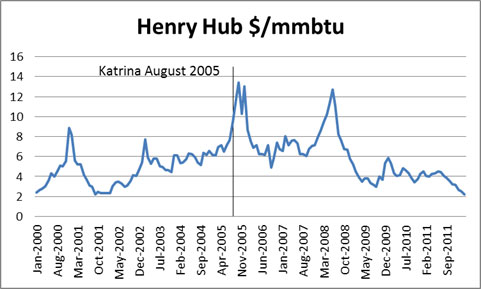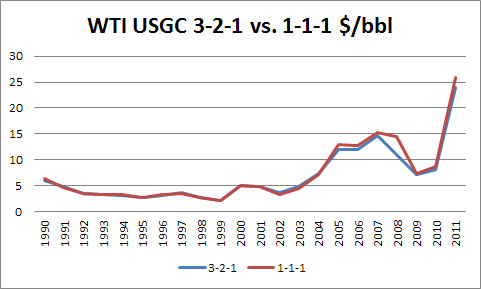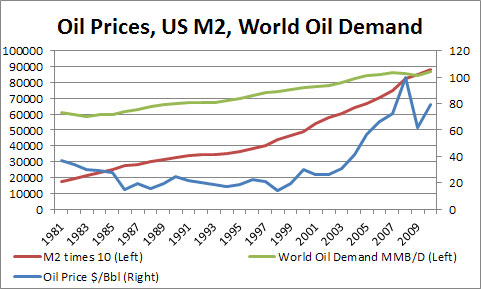Hedging Commodities Is Not Gambling When Done Right
Hedging commodities seems to be a recent interest among many companies I have talked with. There are significant discrepancies of what a hedge really is/should be. Hedging a product can be better worded as insuring an outcome within a certain degree. Those who tout profits and riches are not talking about hedging, but gambling/trading. Gambling/trading does have its own merit when done right, but for this blog I would like to focus on hedging.
Hedging should not be focused on the concept of making money. It should be focused much like insurance. One does not buy insurance to obtain wealth, but to protect against wealth destruction. A proper hedge should protect oneself, commensurate with the level of cost for the hedge. An analogy would be buying a low deductible versus a high deductible insurance. The decision to purchase is the function of perceived risk and financial stability. Another misstatement by many is the fact there could be “free” hedges. There are no free hedges as there are no free cakes.
When to hedge? Hedging makes sense when the product to hedge is not a core part or does not represent a large portion of your business profits. If it does represent a large portion of your business, it should not be represented as only as a hedge, since the product should represent a large core competence of your business. Your team should have a good understanding of the trend and the fundamental nature of the product and be able to effectively trade the product. In the case it represents a smaller portion of your total cost of business, designing an effective hedging program would be a worthy cause.
A hedging program should be tailored and incentivized to reduce volatility and offer a stable cost for projections of earnings. It should not be seen as a profit center. Hedging programs which get caught up in profits eventually becomes a trading program. The hedging program may produce positive results, but these profits should be saved for the rainy days when the hedging program produces negative results. The best hedge programs are systematic.
I have many years in the trading environment along with the corporate planning environment. My group at AEP was instrumental in designing the first approved hedging program by the public utility commission for our supply chains consumption of on-road diesel and gasoline. At All Energy Consulting we understand the energy markets and can effectively navigate you in deciding and designing a hedging program for the various energy commodities. Please contact us to help you evaluate and/or decide on a hedging program.
Your Energy Consultant,
614-356-0484
Coal to gas switching or should we say displacement volumes
Coal to gas switching is much talked about this year. Many people like the switching word; but there is a dynamic that is occurring and also the term switching in the power industry, typically refers to units who have dual fuel. The better word is probably displacement – semantics.
There is two parts to the coal to gas displacement – structural and economic. The structural part is quite easy to discuss. The US market typically has required 50%+ of its generation from coal. Assuming no decline in load growth if coal units retire other units would need to fill in that void of generation. This part is the structural part of the displacement. As many have shown there are significant EPA rules which lead to the retirement of coal units. Now with the addition of the economic competition to coal from low gas price that may exacerbate the volume of retirements. Obviously the selection of which coal unit retirement will likely be based on how much that coal unit is used and how economically competitive it is. Those units who still run significantly will either already have the necessary control equipment to meet the EPA rules or it will likely be economically to install those controls. Therefore for a proxy one could look at the coal generation by plant from last year and stack up the capacity and generation. Also if one is savvy, one can also get a proxy cost of generation from each plant.
Now that you have generation stacked with capacity and cost you can do a calculation to calculate the approximate amount of gas generation if X capacity of coal was going to retire. I would not use a Combine Cycle heat rate (7) since some of that generation may be actually at peak times since some of the older coal plants are likely running at those time. In this example I used an 8 heat rate. Summing the data to produce 20GW of capacity retirements, produces 1.3 bcf/d of additional gas demand. Going to 40 GW of capacity retirements we are looking at 2.7 bcf/d. All this is the structural piece. Given the push for green energy the numbers will be lower some of the above number. The surprising perspective for many is that the gas potential in the power sector can be as dependent on the renewable outlook as the coal outlook.
In terms of the economic portion, this is the very dynamic portion. I have done much work in this arena and have given multiple presentations. This is very dependent on your price outlooks for both gas and coal, particularly on sustainable basis. In addition, time plays a crucial part in the analysis. One has to ask displacement for this week, next month, or next year. Each of those time periods various inputs into a dispatch model must be modified. Also the basis of displacement is being mixed in with natural load growth which in general is being filled in by gas or renewables. Therefore some analysis will say 10 bcf/d of switching will be seen in the next few years, but that includes a load growth which would have occurred regardless. If you are interested in getting some ball park numbers give me a call 614-356-0484 or email me [email protected] and be prepared to tell me the timeline, gas prices, and coal prices.
We positively and evocatively challenge the current thinking involving any aspect of energy use. We look for projects that offer meaningful, transformative, with impactful outcome to the marketplace or society.
Independent analysis and opinions without a bias right is what we offer to our clients. Please consider and contact All Energy Consulting for your consulting needs.
Your Energy Consultant,
The Demise of Coal Overstated
As I noted in my previous blog, I spoke at a power symposium last week. Many of the speakers had concluded coal is dead. The rhetoric is the same on the internet and major publications. People have even spoken to the point to say coal is more expensive than gas. This is sadly far from the truth.
Weather played a key role in the current price predicament for natural gas. One year should never be extrapolated when weather played such a crucial role – case in point look at the price action in natural gas prices after Hurricane Katrina.
It is a true statement for those trading – “Markets can remain irrational longer than you can remain solvent.” You can see it almost took 6 months for Katrina’s price impact to fade. One could look at the current situation as the inverse situation – instead of a hurricane reducing supply you have a mild winter reducing demand. It takes time for fundamentals to rebalance the market. The price rebalancing can take even longer as noted in the irrational markets discussion. The irrational price levels of today’s market are natural gas prices below coal market contracts. Ultimately those contracts will roll off and the negotiations for the coal contracts will come down or no longer cease to exist. Conservatively, I would estimate we are in the fourth month of un-fundamentally low prices. I can foresee continued pressure downward on natural gas prices, but not past this year as long as we revert to normal weather.
For those saying it is over for coal, they are forgetting their game theory rules. For every action there will be a reaction from those most impacted. Coal consumption could potentially drop over 20% this year relative to last year’s consumption. Inversely gas consumption in the power sector could see a rise of over 60% from last year’s consumption. These two actions do not come without consequences/reactions. As I indicated above, I expect coal prices to come down. Inversely, I expect gas prices to rise. It is not if, it is just a matter of when. This combination will allow coal to once again prosper. Coal consumption will not regain its majority spot for generation (>50%) given the environmental policies and the corresponding retirements, but I expect coal will continue to be the top 3 source type of generation for the US for many years to come.
Please do consider All Energy Consulting to help you understand where the markets will be and how best to align your organization to capture the change.
We positively and evocatively challenge the current thinking involving any aspect of energy use. We look for projects that offer meaningful, transformative, with impactful outcome to the marketplace or society.
Independent analysis and opinions without a bias right is what we offer to our clients. Please consider and contact All Energy Consulting for your consulting needs.
Your Energy Consultant,
614-356-0484
Volatility in the Power Markets Inevitable
Last week, I spoke at the Flexible Power Symposium. I will note for my readers that I was rated as one of the highest speakers for the symposium. Many told me first hand, I was the best speaker. Speaking on a stage is natural for me, given my youth background as an aspiring actor. I had the privilege of attending the High School for the Performing Visual Arts in Houston. However, my analytical mind got the best of my aspirations as I looked at my probabilities of success and my required income.
Nonetheless, my talk consisted of laying out the issues confronting the energy markets. I titled my presentation “Unintended Consequences from Good Intentions in the Electric Markets”. As typical of my style of presenting, the slides were much less important than what I had to say. I focused on the three areas on which, as a society ,we should strive for in the electric markets – Renewables, Environmental Policy, and Better Market Design. I made it clear to the audience, I am pro-renewable and environment, but I am also cognizant of the trade-offs. This is probably where I may lose some of you. The externality of the fossil generation is real. The plant is emitting potentially harmful chemicals. However, as in life, there are trade-offs and the corresponding externalities. Extreme environmentalists like to ignore this other side of the equation. Having low cost generation, though more environmentally harmful, offer externality factors of greater expanded use of power which can generate jobs, save lives, and include making society feel better (e.g. comfortable temperature). As I noted in my discussion of the MATS rule by the EPA, our choices to spend for environmental improvements need to be balanced with alternative for use for that capital (financial and human). In addition we really need to understand what our goals are when we plan to spend resources.
Many speakers ahead of me already discussed the variability of renewables in terms of generation. The interesting points in the variability discussions, the wind is hourly whereas the variability of solar is in minutes. In addition, wind is quite spatially consistent. Wind blows simultaneously at the same levels for large regions. Whereas solar can have some balancing effect if there is large regions of solar. I also pointed out the choice of renewables given the higher cost, does take away from the economy as energy is only a means to an end. Many models only consider the wholesale power price, but given renewables are largely done through power purchase agreements (PPA) which are rolled into rates wholesale power prices are less relevant when it pertains to consumer pricing.
Environmental policy already in effect will retire coal units. Many of the coal units support many of the ancillary services: of the electric market – load, following ability, voltage and reactive load support, unit frequency response and system restoration or black start. In a Catch-22, the price signals of each of these services are essentially non-existent due to the large sunk cost in these facilities. There is bound to be a bumpy path as the units get removed from the system and the price signals for investments in these services catch up.
Market design, to regulate or to de-regulate, that is the question. I talked about the pros and cons. Ultimately many markets are already on the path of de-regulation. These markets are bound for market volatility as returns required for investments are higher in de-regulated environment. In addition, high return industries naturally move in business cycles (over to under investments).
In conclusion, given the three areas of renewables: environmental policy, market design, and the future electric markets are bound to see volatile pricing. There will be winners and losers. The losers may be the rate payers as they could see higher prices with less reliability. The winners will be those who have the flexibility and the forethought to skate to where the market will be not where it is now.
Please do consider All Energy Consulting to help you understand where the markets will be and how best to align your organization to capture the change.
We positively and evocatively challenge the current thinking involving any aspect of energy use. We look for projects that offer meaningful, transformative, with impactful outcome to the marketplace or society.
Independent analysis and opinions without a bias right is what we offer to our clients. Please consider and contact All Energy Consulting for your consulting needs.
Your Energy Consultant,
Refining Economics Will Be Focused on Simplicity
Refining in the US has been focused on a premise that never came true. The age old belief in refining economics:
1. Crude oil was going to get heavier and higher in sulfur.
2. Gasoline demand would continue to grow and represent a premium of diesel.
Unfortunately for many, those beliefs never transpired. This belief breakdown can be attributed to the strength of the word markets versus US markets. Crude oil prices breaking beyond the historical norm of $20-40/bbl changed the game.
With prices this high, what was once un-economic now has become proven reserves. These new recoverable supply broke the trend of heavier crudes by offer lighter finds. Shale development is leading to an increase in condensates lightening US refiners feedstock.
The quality of condensates also produces yields of more gasoline than diesel. World oil demand is growing from diesel demand, not gasoline demand. Diesel is the premium product. US refiners had geared up to produce gasoline, only to have the product, not offer the value compared to all the expenses refiners put into to produce gasoline. As seen below, simpler refining setup would produce better margins, particularly if one account for fixed and variable expenses.
What does this all mean and where do we go from here: I expect US gasoline demand to continue to fall this year. Diesel will continue to be the premium product. Even though refining margins seem high relative to history, this is the wrong perspective.
With the higher crude oil price paradigm, one needs to look at margins at a percent of feedstock cost. With a cost of $20/bbl one could be satisfied with a $4/bbl return (20%). However at $100/bbl, a $4/bbl really wouldn’t satisfy the risk or cost. The figure below shows the current margins are not high on a historical basis when one accounts for the underlying feedstock cost.
Refiners who will be successful in this environment will be those who can simplify. Lower operating cost will be the key, as added complexity with additional cost offers no value. Hovensa and Valero Aruba refineries both noted they have much higher operating cost than USGC refiners. This is a result of the higher crude oil price world. Refiners who have access to natural gas can save over $2/bbl on operating cost, as fuel oil prices remain de-coupled from the gas markets.
At All Energy Consulting we have put together forecast for our clients. We can use our expertise for margins calculation to developing a crude oil forecast. If you are evaluating a project/investment, I would suggest calling or emailing All Energy Consulting. We can provide an independent analysis along with key solutions to maximize your potential in making a successful project/investment.
Your Energy Consultant,
David K. Bellman
CERAweek 2012 Summary from the Outside
This years CERAweek marks my first year in almost 10 years in not going to CERAweek. I had the privilege to be invited and speak at CERAweek two times. The amazing thing about CERAweek is the shear size. I have seen it grown from the days in the Galleria area to now at the Hilton Convention Center hotel.
One of the values of being at CERAweek, which you cannot get from reading summaries, comes from the time to reacquaint yourself with your fellow energy colleagues. Also, one of things I always marveled at from being at CERAweek is the logistics of the staff to serve meals. When you attend CERAweek, it is not a buffet line – it is a three course meal for lunch and dinner.
In terms of content summary, Platts did a fine job summarizing many key points in their blog. In addition, twitter works out well when you search #CERAweek. The highlights, I believe, were noteworthy:
CERAweek Oil Day:
I have to agree with Iain Conn, group managing director and chief executive of BP’s worldwide refining and marketing group. Mr. Conn said refinery investments will continue happen in the Atlantic Basin, but it will be strategically done. He also specified he expected to see investments in facilities to take the condensates from the shale development and make products. Those who have been reading my blog will note I made that call early February.
A group made of a good aquiantance Marianne Kuh, Chief Economist ConocoPhillips, and my friend Frank Verrastro, senior vice president and program director at CSIS Energy and National Security Program; noted the high crude oil price is more of a function of actual demand growth, not only political uncertainty of Iran. I do agree with these points, but I still think monetary policy has influenced the price of oil as significantly as demand, if not more.
To prove my point, I have pulled annual oil prices, M2 money supply, and oil demand since 1981. I have graphed the information below. I also ran regressions on each of the variables to oil price. M2 money supply has a better R^2 with 0.61 vs. 0.48. Together they produce a rather strong correlation for an R^2 of 0.70. Another interesting outcome of this analysis is it shows for the first time the amount of M2 is now greater than 10% of the world demand expressed in millions of barrels/day. This started in 2009 as the FED aggressively moved to “save” the system.
CERAweek Gas Day:
There were several discussions of natural gas vehicles. I think it’s a clear choice for fleets to convert to natural gas. Mass transit vehicles should move towards CNG. There was discussion on a recent article in the Wall Street Journal by Robert McFarlane, served as President Reagan’s national security adviser from 1983-85. In the article Mr. McFarlane talks about methanol vehicles. Speakers at CERAweek disagreed with him largely on the premise of structural issues. I think the more valid concern would be the history and fate of MTBE. From what I have gathered methanol would be more toxic than MTBE. I do disagree in how we handle the MTBE issue – requiring MTBE then banning it. MTBE was a messenger to a problem that is still happening. MTBE gave you a mechanism to trace and track leaking gasoline. By eliminating MTBE you did not solve the real problem.
Apache CEO, Steven Farris, made remarks in regards to supplying utilities with long-term contracts, but with a floating gas price. Once again I have blogged about this before. It would be worthwhile to continue to watch this evolution. Many are trying to emulate coal contracts, but the reason and the value of contracting gas is not the same as it was with coal.
Of course it wouldn’t be gas day without a deluge of shale discussion and fracking concerns. Many speakers talked about transparency and the efficacy of fracking. I will have to agree here that it can be done in a responsible and safe way. It is a matter of regulators to effectively regulate, because there will always be bad actors.
My former consulting company, Purvin & Gertz, who got acquired by IHS had their own session at CERAweek. They spoke about the NGL markets. Once again I did note about the dynamics of what is going on in this market in my previous blogs. This is an exciting area, full of opportunities.
CERAweek Power Day:
For some reason, the day opened with a discussion of nuclear renaissance. I will have to agree with GE CEO Immelt – there has never been or will be a nuclear renaissance in the US. I will add the caveat – unless significant structural changes are made to our electric industry design. This country has cost-effective options whereas other countries do not (e.g. France, Japan, etc…).
I will have to differ with many of Alstoms thoughts. Alstom has been a very vocal and huge supporter of CERAweek for the past few years. They spoke many times during the conferences. I have read that they still are investing heavily in CCS. They believe the focus for clean energy should be on the technology side. Once again in my blogs, I elude to the point it is not the technology that is limiting “clean” energy; it is the business strategy and incentives. They also point out that gas generation should focus on bigger turbines with lower cost. Of course, that sounds ideal, but I think over the next 3 years the value proposition will be for more dynamic turbines versus bigger and efficient. I say this because of the need to serve the intermittent nature of wind.
FERC commission, Philip D. Moeller, discussed the point that the consumer needed to see the real price. I believe he is trying to point out the desire of real-time metering. However I will disagree with this since there are several ways to make pricing more transparent to the consumer. Rate design in itself does not hide the cost of power, since regulation comes with cost recovery. It is the actors behind the rate design that hide the true cost of power – as noted in my previous blog. Real-time pricing will change consumption, but the bulk of the impact could be done by having block metering – on and off-peak hours with no dynamic pricing, but a statement to the consumer. The hours between 7am-10pm will be more expensive than 10pm-7am. This method would come at a fraction of the cost and involve much less complexity. I do understand the value of the “smart” grid that it comes from other forms, such as reliability; but this is not how it is being sold to the consumer.
I couldn’t agree more with CEO and President Bruce Grewcock of Kiewet – “In a lot of jurisdictions, people are going to see rate shock when they see the true costs.” Once again this is not coming from a smart grid realtime perspective, but the fact that there has been an underinvestment by the utilities. Instead of focusing on true needs over the past years, we have focused on projects and mechanism of style (e.g. CCS, IGCC, fuel deferral, smart grid, etc…). Inefficiency in markets will always come back to haunt you.
We positively and evocatively challenge the current thinking involving any aspect of energy use. We look for projects that offer meaningful, transformative, with impactful outcome to the marketplace or society.
Independent analysis and opinions without a bias right is what we offer to our clients. Please consider and contact All Energy Consulting for your consulting needs.
Your Energy Consultant,












